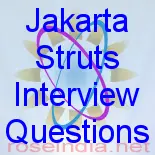Jakarta Struts Interview Questions
Q: What is Jakarta Struts Framework?A: Jakarta Struts is open source implementation of MVC (Model-View-Controller) pattern for the development of web based applications. Jakarta Struts is robust architecture and can be used for the development of application of any size. Struts framework makes it much easier to design scalable, reliable Web applications with Java.

Q: What is ActionServlet?
A: The class org.apache.struts.action.ActionServlet is the called
the ActionServlet. In the the Jakarta Struts Framework this class plays the
role of controller. All the requests to the server goes through the
controller. Controller is responsible for handling all the requests.
Q: How you will make available any Message
Resources Definitions file to the Struts Framework Environment?
A: Message Resources Definitions file are simple .properties files and
these files contains the messages that can be used in the struts project. Message
Resources Definitions files can be added to the struts-config.xml file
through <message-resources />
tag.
Example:
<message-resources parameter="MessageResources" />
Q: What is Action Class?
A: The Action is part of the controller. The purpose of Action Class is to translate the
HttpServletRequest
to the business logic. To use the Action, we need to Subclass and
overwrite the execute() method. The ActionServlet (commad)
passes the parameterized class to Action Form using the execute()
method. There should be no database interactions in the action. The action should receive the request, call business objects (which then handle database, or interface with J2EE, etc) and then determine where to go next. Even better, the business objects could be handed to the action at runtime (IoC style) thus removing any dependencies on the model.
The return type of the execute method is ActionForward which
is used by the Struts Framework to forward the request to the file as per
the value of the returned ActionForward object.
Q: Write code of any Action Class?
A: Here is the code of Action Class that returns the ActionForward object.
TestAction.java
|
A: An ActionForm is a JavaBean that extends
org.apache.struts.action.ActionForm.
ActionForm maintains the session state for web application and the
ActionForm object is automatically populated on the server side with data
entered from a form on the client side.Q: What is Struts Validator Framework?
A: Struts Framework provides the functionality to validate
the form data. It can be use to validate the data on the users browser as well
as on the server side. Struts Framework emits the java scripts and it can be
used validate the form data on the client browser. Server side validation of
form can be accomplished by sub classing your From Bean with DynaValidatorForm
class.
The Validator framework was developed by David
Winterfeldt as third-party add-on to Struts. Now the Validator framework is a
part of Jakarta Commons project and it can be used with or without Struts. The
Validator framework comes integrated with the Struts Framework and can be used
without doing any extra settings.
Q. Give the Details of XML files used in Validator
Framework?
A: The Validator Framework uses two XML configuration files validator-rules.xml
and validation.xml. The validator-rules.xml defines the standard
validation routines, these are reusable and used in validation.xml. to
define the form specific validations. The validation.xml defines the
validations applied to a form bean.
Q. How you will display validation fail errors on
jsp page?
A: Following tag displays all the errors:
<html:errors/>
Q. How you will enable front-end validation based on the xml in
validation.xml?
A: The <html:javascript> tag to allow front-end validation based on the xml in
validation.xml. For example the code: <html:javascript formName="logonForm"
dynamicJavascript="true" staticJavascript="true" />
generates the client side java script for the form "logonForm" as
defined in the validation.xml file. The <html:javascript>
when added in the jsp file generates the client site validation script.



